The Snapdragon 845 Performance Preview: Setting the Stage for Flagship Android 2018
by Ryan Smith & Andrei Frumusanu on February 12, 2018 12:30 AM EST- Posted in
- Mobile
- Snapdragon
- Qualcomm
- Smartphones
- SoCs
- Snapdragon 845
GPU Performance & Power Estimates
One of the larger changes that the Snapdragon 845 brings with itself is a new GPU architecture. Qualcomm has been traditionally very secretive when talking about details of their Adreno GPUs and the Adreno 630 is no different here. Truth to be told, the only real sign that we’re looking at more major architectural changes is the transition from the Adreno 5xx series to the Adreno 6xx series.
While the Adreno 630 remains largely a black box we do know what Qualcomm’s claims for the GPU are. We’re looking at overall 30% better performance and a 30% improvement in power. The latter point is something that Qualcomm liked to showcase both at the announcement of the Snapdragon 845 as well as for this benchmarking event, however it needs to be clarified that the power improvement is measured at iso-performance levels. Naturally because the 845 targets higher performance points the power would be higher than at 835-levels of performance. Regardless of this marketing nit-pick, we’re still expecting an efficiency increase at peak performance levels if the resulting absolute power remains at the same levels as the Snapdragon 835.

We start off with Futuremark’s 3DMark Sling Shot 3.1 Extreme Unlimited test. The graphics test mainly showcases the GPU improvements of a system and here the Snapdragon 845 easily reaches its performance target, improving by up to 32% compared to the Snapdragon 835 powered Pixel 2 XL and Galaxy S8. This is an astonishingly great achievement for Qualcomm in one generation.
When we’re looking at competitor devices we see only the the iPhone X able to compete with the last generation Snapdragon 835 devices – however with a catch. The A11 is severely thermally constrained and is only able to achieve these scores when the devices are cold. Indeed as seen from the smaller score of the iPhone 8, the SoC isn’t able to sustain maximum performance for even one benchmark run before having to throttle. Unfortunately this also applies to current and last generation Exynos and Kirin SoCs as both shed great amount of performance after only a few minutes. I’ve addressed this issue and made a great rant about it in our review of the Kirin 970. For this reason going forward AnandTech is going to distinguish between Peak and Sustained scores across all 3D benchmarks. This however needs to be tested on commercial devices as the QRD platform isn’t a thermally representative phone for the SoC, so until that happens, we’ll have to just estimate based on power consumption where the Snapdragon 845 ends up.
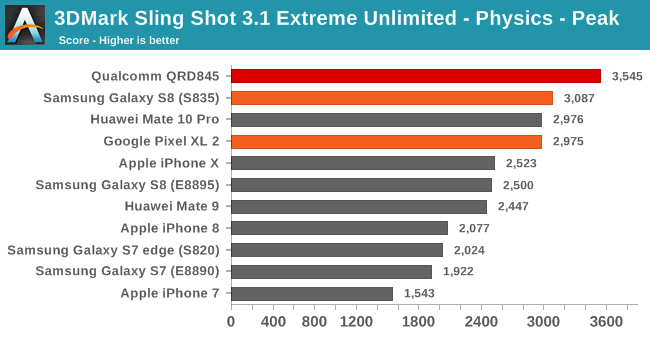
The physics score is a CPU-bound test and less limited by the GPU. Here the Snapdragon 845 provides a good improvement over the Snapdragon 835 however to a meagre 14% increase which incidentally matches the clock frequency increase between the 845 and 835’s performance CPUs.
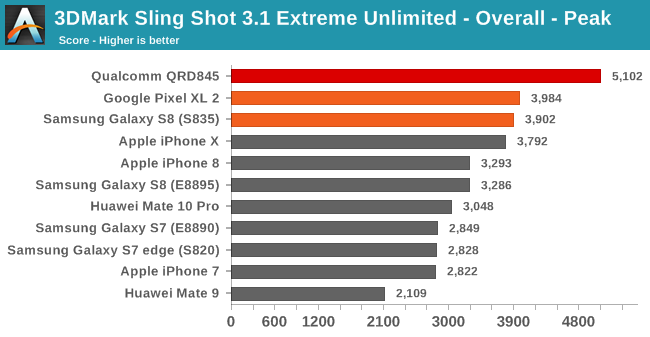
Overall the QRD845 platform leads the Sling Shot Extreme rankings by a comfortable margin.
Moving on to GFXBench I decided to focus on T-Rex and Manhattan 3.1 as both tests stress different aspects of the GPU, fill-rate and texturing bound workloads versus more arithmetic bound workloads.

In T-Rex the Snapdragon 845 again shows an impressive 31% increase over the Snapdragon 835. This time around it’s not enough to quite match the Apple A11 but I expect that situation to quickly reverse as the latter becomes thermally constrained.
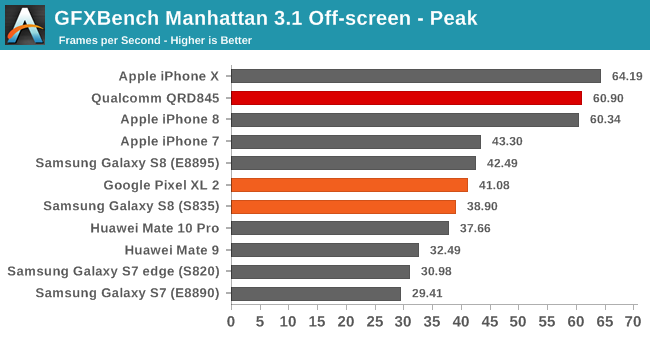
Manhattan 3.1 is more shader and compute heavy and thus puts more stress on the ALU pipelines of the GPU. Here the Adreno 630 outpaces the Adreno 540 by an ever impressive 48%. Again the A11 matches the performance here but with a device becoming very hot quite fast while the QRD845 was merely luke-warm in our preview benchmarking session.
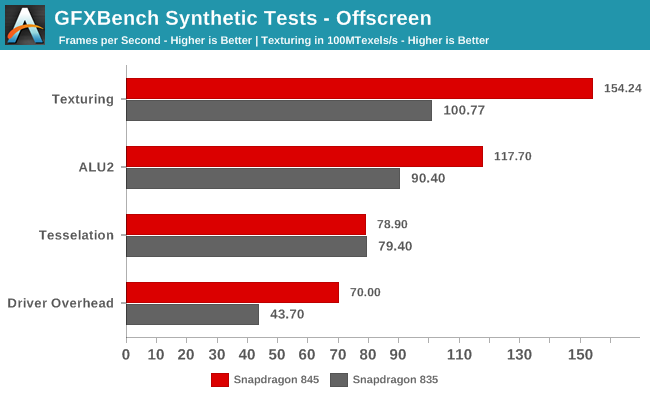
GFXBench’s synthetic micro-tests should shed more light on the architectural improvements of the Adreno 640. Indeed looking at the results we see that the Snapdragon 845 is able to achieve an over 50% increase in the texturing test to an unmatched 15400MTexels/s. Qualcomm’s claims of 2.5x faster display throughput more than likely involves also vastly increased pixel fillrate capabilities on the side of the GPU so the architecture must have increased the number of ROPs and texturing units to get to such scores.
The ALU2 test shows a 30% increase in performance over the Snapdragon 845, however the fact that Manhattan 3.1’s score increased by up to 48% means that we’re likely seeing a more fundamental change in the ALU pipelines that lead to better utilisation ratio.
The tessellation results point out that the geometry pipelines haven’t received any large improvements. One fact-check that we unfortunately weren’t able to verify is the clock frequency of the Adreno 640. The fact that the tessellation test ends up in spitting distance of the Adreno 630 means that we’re very likely looking at clocks very similar to the Adreno 630 – in the 670 to 710MHz range.
Finally the driver overhead score shows both the increased raw CPU performance of the Snapdragon 845 as well as maybe an improvement in Qualcomm’s drivers.
As beforementioned, going forward we’re going to have a more heavy focus on GPU sustained performance as well as power. During the benchmarking session we were able to probe the QRD845 for power as measured by the fuel gauge by the PMIC. We must however note that these platforms aren’t usually power optimised and have early silicon bins – Qualcomm themselves don’t advise them for power measurements. Nevertheless curiosity got the best of us and the following estimated figures should be seen as worst-case scenarios for the Snapdragon 845.
| GFXBench Manhattan 3.1 Offscreen Power Efficiency (System Active Power) |
||||
| Mfc. Process | FPS | Avg. Power (W) |
Perf/W Efficiency |
|
| Qualcomm QRD (Snapdragon 845) | 10LPP | 60.90 | ~4.38 | 13.90 fps/W |
| Galaxy S8 (Snapdragon 835) | 10LPE | 38.90 | 3.79 | 10.26 fps/W |
| LeEco Le Pro3 (Snapdragon 821) | 14LPP | 33.04 | 4.18 | 7.90 fps/W |
| Galaxy S7 (Snapdragon 820) | 14LPP | 30.98 | 3.98 | 7.78 fps/W |
| Huawei Mate 10 (Kirin 970) | 10FF | 37.66 | 6.33 | 5.94 fps/W |
| Galaxy S8 (Exynos 8895) | 10LPE | 42.49 | 7.35 | 5.78 fps/W |
| Galaxy S7 (Exynos 8890) | 14LPP | 29.41 | 5.95 | 4.94 fps/W |
| Meizu PRO 5 (Exynos 7420) | 14LPE | 14.45 | 3.47 | 4.16 fps/W |
| Nexus 6P (Snapdragon 810 v2.1) | 20Soc | 21.94 | 5.44 | 4.03 fps/W |
| Huawei Mate 8 (Kirin 950) | 16FF+ | 10.37 | 2.75 | 3.77 fps/W |
| Huawei Mate 9 (Kirin 960) | 16FFC | 32.49 | 8.63 | 3.77 fps/W |
| Huawei P9 (Kirin 955) | 16FF+ | 10.59 | 2.98 | 3.55 fps/W |
For Manhattan 3.1 the Snapdragon 845 had an active system power figure (Idle power subtracted from total platform power) of 4.38W. The excellent performance figure of the Adreno 630 alongside the reasonable power consumption puts the Snapdragon 845 well ahead at the top of our efficiency table, improving by up to 35% compared to the S835 Galaxy S8, with three generations of Adreno based SoC outmatching the latest ARM solutions. We’re aware of the demand for power figures on Apple’s latest SoCs but sadly we can’t tear down our review devices for battery power measurements and working on a solution. Given the A11’s thermal characteristics I’m expecting power usages more in line with the Exynos 8895 and Kirin 970 than the Snapdragon SoCs.
| GFXBench T-Rex Offscreen Power Efficiency (System Active Power) |
||||
| Mfc. Process | FPS | Avg. Power (W) |
Perf/W Efficiency |
|
| Qualcomm QRD (Snapdragon 845) | 10LPP | 150.80 | ~4.02 | 37.51 fps/W |
| Galaxy S8 (Snapdragon 835) | 10LPE | 108.20 | 3.45 | 31.31 fps/W |
| LeEco Le Pro3 (Snapdragon 821) | 14LPP | 94.97 | 3.91 | 24.26 fps/W |
| Galaxy S7 (Snapdragon 820) | 14LPP | 90.59 | 4.18 | 21.67 fps/W |
| Galaxy S8 (Exynos 8895) | 10LPE | 121.00 | 5.86 | 20.65 fps/W |
| Galaxy S7 (Exynos 8890) | 14LPP | 87.00 | 4.70 | 18.51 fps/W |
| Huawei Mate 10 (Kirin 970) | 10FF | 127.25 | 7.93 | 16.04 fps/W |
| Meizu PRO 5 (Exynos 7420) | 14LPE | 55.67 | 3.83 | 14.54 fps/W |
| Nexus 6P (Snapdragon 810 v2.1) | 20Soc | 58.97 | 4.70 | 12.54 fps/W |
| Huawei Mate 8 (Kirin 950) | 16FF+ | 41.69 | 3.58 | 11.64 fps/W |
| Huawei P9 (Kirin 955) | 16FF+ | 40.42 | 3.68 | 10.98 fps/W |
| Huawei Mate 9 (Kirin 960) | 16FFC | 99.16 | 9.51 | 10.42 fps/W |
T-Rex stresses the GPU differently and we see slightly lower power consumption compared to Manhattan 3.1 ending up at 4W and showcasing an efficiency increase of 20% over the Snapdragon 835, again pointing towards more tangible changes in the ALU pipelines of the new architecture.
Overall the Adreno 630 more than delivers as it’s able to double-down on the Adreno 540’s efficiency advantage. Qualcomm current generations of SoCs are simply unmatched and the gap is so wide that I do not expect upcoming rival solutions to be able to catch up this year.


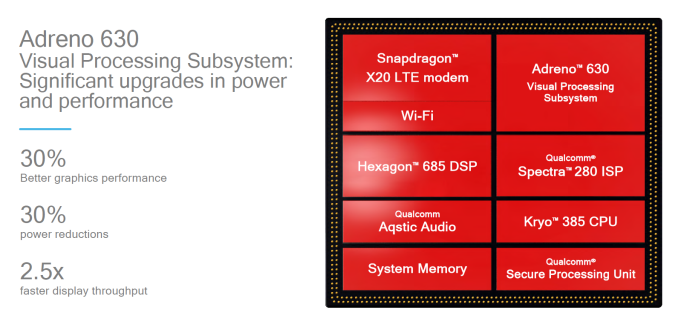








140 Comments
View All Comments
Lodix - Monday, February 12, 2018 - link
That they make their own chip.ZolaIII - Monday, February 12, 2018 - link
Actually A75 is a bit of a let down. As it's actually refined A73 with tree instructions per clock vs two. I assume that with larger cache, bigger predictor & everything else it's also close of being 50% larger while it's able to achieve only 20~25% performance advantage. Nevertheless if compared to A71 which is similar 3 instructions per clock design advantage is nice 30~35%. Neither is really a server material & you know that pretty good (of all people around hire). We will have to wait & see what Austin will cook up next.ZolaIII - Monday, February 12, 2018 - link
One more thing FP VFP & especially NEON got a most significant boost with A75 - A73, that's actually only really architectural improvement on this generation. FP performance is very important as it scales rather good on the SMP while integer doesn't. Still giving MP scaling factor & relative power efficiency/performance the A55's are still much better target for such workloads using 25% power & achieving 85% performance per MHz. Arm's NEON SIMD whose marginally unusable before this gen. as on the previous VFP had 98% of NEON performance while (VFP) being much faster to access so in many real workloads actually faster. ARM boosted NEON performance but in my opinion not even close enough to go in a higher tear. I do agree with you that Integer performance is actually rather very good for small, efficient little OoO core but ARM must do much more on the FP - NEON SIMD if it wants that their cores become more competitive in HPC segment. Actually I see this as a key (FP performance). Hopefully they will produce a next key architectural element of unified SIMD with added multiply, divide subs on it as I see that as the best possible scaling/performance improvement & also as future avoiding of black silicone. Actually regarding large NEON SIMD blocks usage & in the purpose of server scientific HPC workloads the Fujitsu started working on it long time ago (two + years ago). I just wonder what happened with that.iter - Monday, February 12, 2018 - link
You are confusing integer and floating point with scalar and vector. SIMD units do vector processing, the vector components can be either integer or floating point. Both are equally useful in HPC, and both get a massive boost from SIMD processing. It is the ALU and the FPU units that do scalar processing, that is one number at a time, of integers and floating point numbers respectively. Those are not used for data crunching, but for managing the program flow, which is beneficial since the lower throughput also means lower latency.There is no such thing as a free lunch here. If you want to stay at a lower power target, you have to compromise on the SIMD throughput. There is no way to cheat around that. If ARM chips get SIMD units to match x86 counterparts they will also match their higher power usage.
ZolaIII - Monday, February 12, 2018 - link
Lol both scalar and vector are FP. I ain't confusing anything, you are... SIMD's are rather efficient, more efficient for an order of magnitude compared to the VFP, that's why SIMD arias find their way to pretty much any special purpose or general purpose computing unit's. What I told is a massive united heterogeneous SIMD aria... Now think about it.iter - Tuesday, February 13, 2018 - link
You are such a dummy. Scalar means "one number", vector means "two or more numbers". The number can be an integer or a floating point number. SIMD instruction sets feature dozens of instructions for processing integer numbers, which are essential to image, video and audio processing, which is all stored using integers.In fact, the first SIMD implementation to hit consumer products was intel's MMX, which provided ONLY INTEGER operations.
As I said - scalar operations involve processing one number of a time, and are executed by the ALU or FP unit for integers and real numbers respectively, vector operations involve processing multiple numbers at once, and is handled by the SIMD units, regardless of whether its integers or reals.
lmcd - Monday, February 12, 2018 - link
Wouldn't get too excited, as A75 was reported to feature a variant of the "Meltdown" bug also affecting Intel CPUs. Performance hit for a patch could be damaging.SirPerro - Monday, February 12, 2018 - link
I'm more interested in the mid-range processors to drive devices like the Moto G Plus seriesRight now, an SD845 is extraordinarily excessive for like... 95% of the Android use cases.
It's like... "OK, that 1080 Ti GPU is really nice, but how good is the 1060 I will actually pay for?"
imaheadcase - Monday, February 12, 2018 - link
The irony of all this is that software is going to make the difference more than this SoC. You can have the best SoC and put in a shit phone.yeeeeman - Monday, February 12, 2018 - link
First of all nice review Andrei, coming from a romanian guy like you.Related to SD845, this chip is a nice bump over 835, but I cannot help but wonder if this yearly cadence is really a necessity or just a money grabbing, each year, thing.
I want to change my Z3 compact, SD801 phone with something new, but I feel like what is best, has yet to come. In 2019 we will have 5G modems, 11ax wifi chips, new uArch from ARM aaand 7nm. This chip is just a intermediate step to have something to sell this year, but in any case, nice work as usual from Qualcomm.